A Fast Sequential Similarity Detection Algorithm for Multi-Source Image Matching
Abstract
1. Introduction
- (1)
- An efficient and robust image matching framework is proposed based on phase congruency to achieve pixel-level matching. The proposed framework integrates different types of local features for similarity measurement.
- (2)
- A novel feature descriptor (CFPC) is constructed based on the oriented gradient and response intensity of phase congruency to capture structure information.
- (3)
- The proposed matching method uses pixel-level feature representation to evaluate the similarity between multi-source images, and also, a similarity measurement method (F-SSDA) is established to accelerate image matching. Therefore, the intrinsic geometry information is incorporated into the objective function formulation when computing similarity measurements between multi-source images to improve matching performance.
2. Related Work
2.1. Area-Based Methods
2.2. Feature-Based Methods
3. Methodology and Material
3.1. Basic Framework of the Proposed Matching Algorithm
3.2. Channel Features of Phase Consistency
3.3. The Frequency Sequential Similarity Detection Algorithm
3.4. Description of Datasets
- (a)
- Visible–SAR: Visible–SAR data 1 and 3 were acquired over urban areas with tall buildings, resulting in significant radiometric differences between them. Visible–SAR 2 is a medium-resolution image in a suburban area. In addition, significant changes had occurred in this area as the SAR image was taken 14 months after the visible image in Visible–SAR 2, thereby complicating the matching process.
- (b)
- LiDAR–Visible: LiDAR–Visible images is collected in urban areas. Significant noise and nonlinear radiometric differences make it more challenging to match LiDAR image data.
- (c)
- Visible–infrared: Both medium- and high-resolution images were used (Daedalus and Landsat 5 TM). The medium-resolution data were acquired over a suburban area.
- (d)
- Visible–map: These data were collected from Google Earth. The images had been rasterized, and there was local distortion between image pairs due to the relief displacement of buildings. In addition, there were radiometric differences between the map data and visible images. The lack of texture features to construct local descriptors makes it challenging to match an image to a map.
4. Experiments
4.1. Parameters and Evaluation Criteria
4.2. Tests for Similarity Measurement
4.3. Precision
4.4. Ablation Experiment
5. Conclusions
Author Contributions
Funding
Data Availability Statement
Acknowledgments
Conflicts of Interest
References
- Li, R.; Gao, X.; Shi, F. Scale Effect of Land Cover Classification from Multi-Resolution Satellite Remote Sensing Data. Sensors 2023, 23, 6136. [Google Scholar] [CrossRef]
- Wang, C.; Xu, L.; Xu, R. Triple Robustness Augmentation Local Features for multi-source image registration. ISPRS J. Photogramm. Remote Sens. 2023, 199, 1–14. [Google Scholar] [CrossRef]
- Li, X.; Lyu, X.; Tong, Y. An object-based river extraction method via optimized transductive support vector machine for multi-spectral remote-sensing images. IEEE Access 2019, 7, 46165–46175. [Google Scholar] [CrossRef]
- Lati, A.; Belhocine, M.; Achour, N. Fuzzy correlation based algorithm for UAV image mosaic construction. Multimed. Tools Appl. 2024, 1, 3285–3311. [Google Scholar] [CrossRef]
- Hu, J.; Hu, P.; Wang, Z. Spatial dynamic selection network for remote-sensing image fusion. IEEE Geosci. Remote Sens. Lett. 2021, 19, 8013205. [Google Scholar] [CrossRef]
- Zhang, C.; Wang, L.; Cheng, S. SwinSUNet: Pure transformer network for remote sensing image change detection. IEEE Trans. Geosci. Remote Sens. 2022, 60, 5224713. [Google Scholar] [CrossRef]
- Pallotta, L.; Giunta, G.; Clemente, C. Subpixel SAR image registration through parabolic interpolation of the 2-D cross correlation. IEEE Trans. Geosci. Remote Sens. 2020, 58, 4132–4144. [Google Scholar] [CrossRef]
- Cole-Rhodes, A.; Johnson, L.; LeMoigne, J. Multiresolution registration of remote sensing imagery by optimization of mutual information using a stochastic gradient. IEEE Trans. Image Process. 2003, 12, 1495–1511. [Google Scholar] [CrossRef]
- Ye, Y.; Shan, J.; Bruzzone, L. Robust registration of multimodal remote sensing images based on structural similarity. IEEE Trans. Geosci. Remote Sens. 2017, 55, 2941–2958. [Google Scholar] [CrossRef]
- Wu, Q.; Zhu, S. Multispectral Image Matching Method Based on Histogram of Maximum Gradient and Edge Orientation. IEEE Geosci. Remote Sens. Lett. 2021, 19, 1–5. [Google Scholar] [CrossRef]
- He, H.; Chen, Z.; Liu, H.; Guo, Y.; Li, J. Practical Tracking Method based on Best Buddies Similarity. Cyborg Bionic Syst. 2023, 4, 50. [Google Scholar] [CrossRef]
- Ma, W.; Wu, Y.; Liu, S. Remote sensing image registration based on phase congruency feature detection and spatial constraint matching. IEEE Access 2018, 6, 77554–77567. [Google Scholar] [CrossRef]
- Ma, J.; Chan, C.; Canters, F. Fully automatic subpixel image registration of multiangle CHRIS/Proba data. IEEE Trans. Geosci. Remote Sens. 2010, 48, 2829–2839. [Google Scholar]
- Pluim, P.; Maintz, A. Image registration by maximization of combined mutual information and gradient information. In Proceedings of the Medical Image Computing and Computer-Assisted Intervention–MICCAI 2000: Third International Conference, Pittsburgh, PA, USA, 11–14 October 2000. [Google Scholar]
- Shechtman, E.; Irani, M.; Xu, R. Matching local self-similarities across images and videos. In Proceedings of the 2007 IEEE Conference on Computer Vision and Pattern Recognition, Minneapolis, MN, USA, 17–22 June 2007. [Google Scholar]
- Liu, J.; Zeng, G.; Fan, J. Fast local self-similarity for describing interest regions. Pattern Recognit. Lett. 2012, 33, 1224–1235. [Google Scholar] [CrossRef]
- Sedaghat, A.; Xu, L.; Xu, R. Distinctive order based self-similarity descriptor for multi-sensor remote sensing image matching. ISPRS J. Photogramm. Remote Sens. 2023, 108, 62–71. [Google Scholar] [CrossRef]
- Jenkinson, P.; Bhushan, M. MIND: Modality independent neighbourhood descriptor for multi-modal deformable registration. Med. Image Anal. 2012, 16, 1423–1435. [Google Scholar]
- Wu, Q.; Xu, G.; Cheng, Y. Robust and efficient multi-source image matching method based on best-buddies similarity measure. Infrared Phys. Technol. 2019, 101, 88–95. [Google Scholar] [CrossRef]
- Ye, Y.; Bruzzone, L.; Shan, J. Fast and robust matching for multimodal remote sensing image registration. IEEE Trans. Geosci. Remote Sens. 2019, 57, 9059–9070. [Google Scholar] [CrossRef]
- Lowe, D. Distinctive image features from scale-invariant keypoints. Int. J. Comput. Vis. 2004, 60, 91–110. [Google Scholar] [CrossRef]
- Rublee, E.; Rabaud, V.; Konolige, K. ORB: An efficient alternative to SIFT or SURFs. IEEE Comput. Soc. Conf. Comput. Vis. Pattern Recognit. 2011, 199, 2564–2571. [Google Scholar]
- Morel, M.; Yu, G. ASIFT: A new framework for fully affine invariant image comparison. SIAM J. Imaging Sci. 2009, 2, 438–469. [Google Scholar] [CrossRef]
- Dellinger, F.; Delon, J.; Gousseau, Y. SAR-SIFT: A SIFT-like algorithm for SAR images. IEEE Trans. Geosci. Remote Sens. 2014, 53, 453–466. [Google Scholar] [CrossRef]
- Sedaghat, A.; Ebadi, H. Remote sensing image matching based on adaptive binning SIFT descriptor. IEEE Trans. Geosci. Remote Sens. 2015, 53, 5283–5293. [Google Scholar] [CrossRef]
- Zhu, X.; Huang, Z.; Ding, M. Non-rigid multi-modal brain image registration based on two-stage generative adversarial nets. Neurocomputing 2022, 505, 44–57. [Google Scholar] [CrossRef]
- Fu, C.; Yuan, H.; Xu, H.; Zhang, H.; Shen, L. TMSO-Net: Texture adaptive multi-scale observation for light field image depth estimation. J. Vis. Commun. Image Represent. 2023, 90, 103731. [Google Scholar] [CrossRef]
- Tang, L.; Deng, Y.; Ma, Y. SuperFusion: A versatile image registration and fusion network with semantic awareness. IEEE/CAA J. Autom. Sin. 2022, 9, 2121–2137. [Google Scholar] [CrossRef]
- Yang, T.; Bai, X.; Cui, X. DAU-Net: An unsupervised 3D brain MRI registration model with dual-attention mechanism. Int. J. Imaging Syst. Technol. 2023, 33, 217–229. [Google Scholar] [CrossRef]
- Sun, J.; Shen, Z.; Wang, Y.; Bao, H.; Zhou, X. LoFTR: Detector-free local feature matching with transformers. In Proceedings of the IEEE/CVF Conference on Computer Vision and Pattern Recognition, Virtual Conference, 19–25 June 2021. [Google Scholar]
- Wu, Q.; Xu, G.; Cheng, Y. A deformed contour segment matching for multi-source images. Pattern Recognit. 2021, 117, 107968. [Google Scholar] [CrossRef]
- Meng, X.; Yang, G.; Yin, Y. Finger vein recognition based on local directional code. Sensors 2012, 12, 14937–14952. [Google Scholar] [CrossRef] [PubMed]
- Aguilera, C.; Barrera, F. Multispectral image feature points. Sensors 2012, 12, 12661–12672. [Google Scholar] [CrossRef]
- Wu, Q.; Xu, G.; Cheng, Y. Histogram of maximal point-edge orientation for multi-source image matching. Int. J. Remote Sens. 2020, 41, 5166–5185. [Google Scholar] [CrossRef]
- Ye, Y.; Shen, L. Hopc:A novel similarity metric based on geometric structural properties for multi-modal remote sensing image matching. ISPRS Ann. Photogramm. 2016, 3, 9–16. [Google Scholar]
- Wu, Q.; Li, H.; Zhu, S. Nonlinear intensity measurement for multi-source images based on structural similarity. Measurement 2021, 179, 109474. [Google Scholar] [CrossRef]
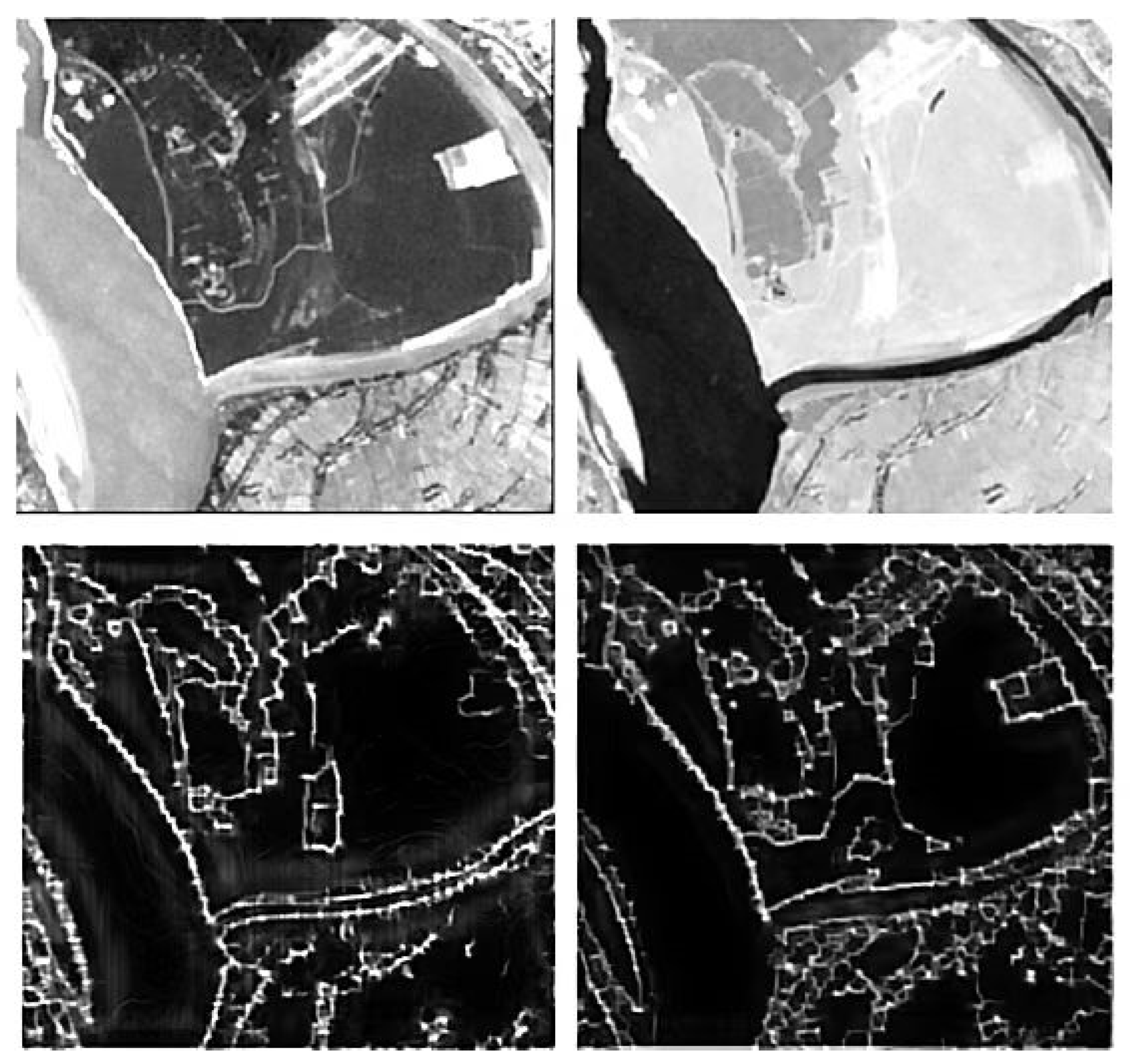

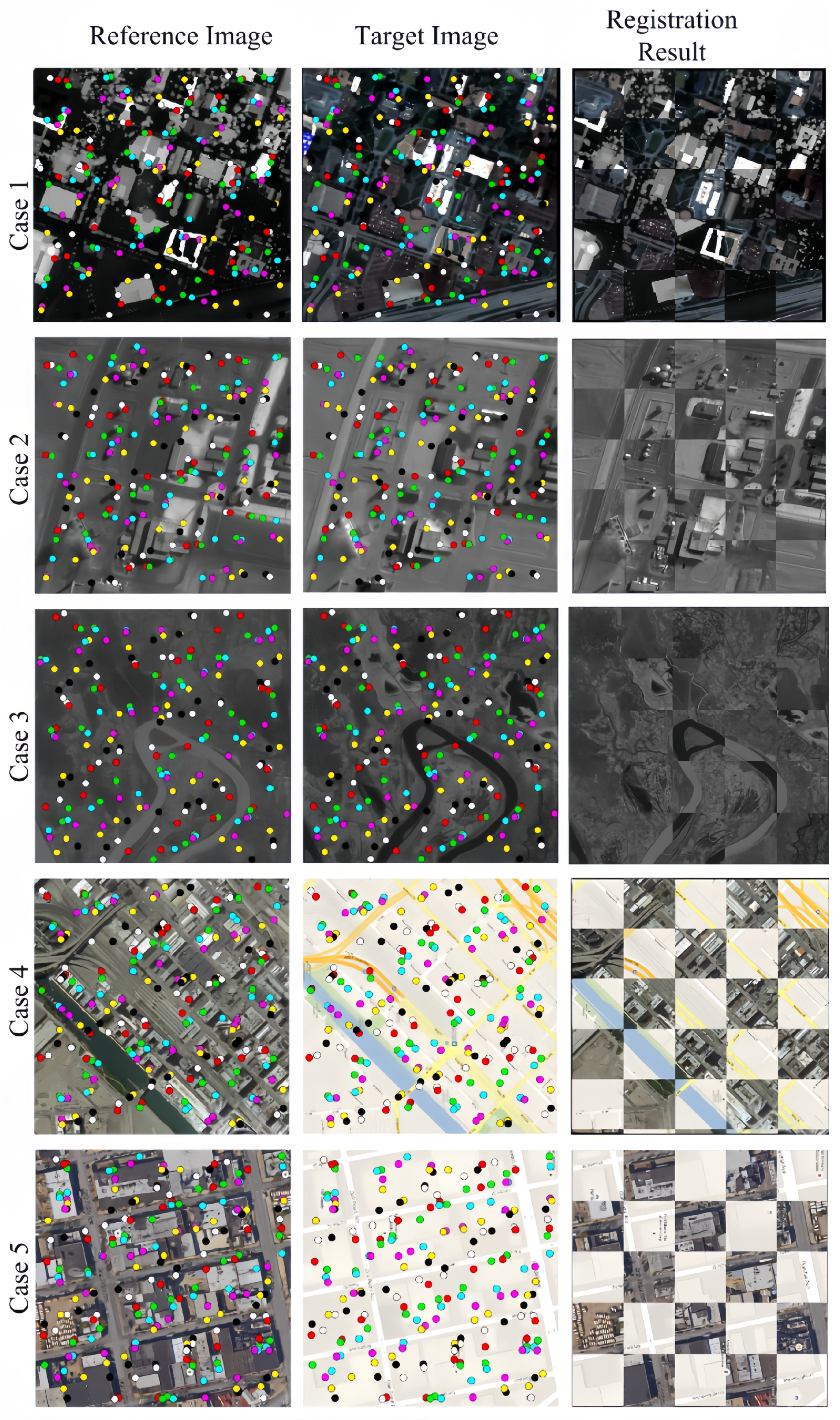



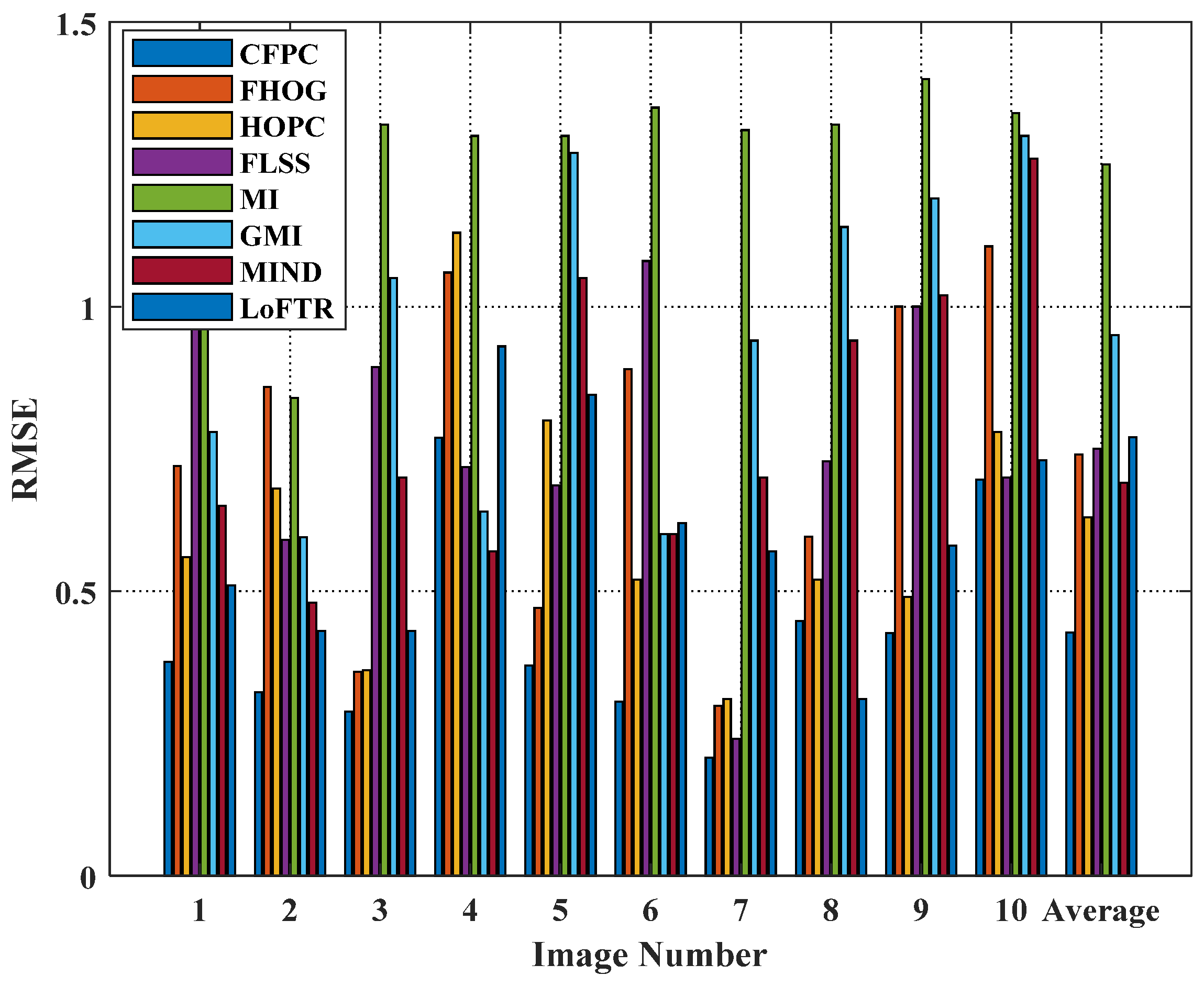

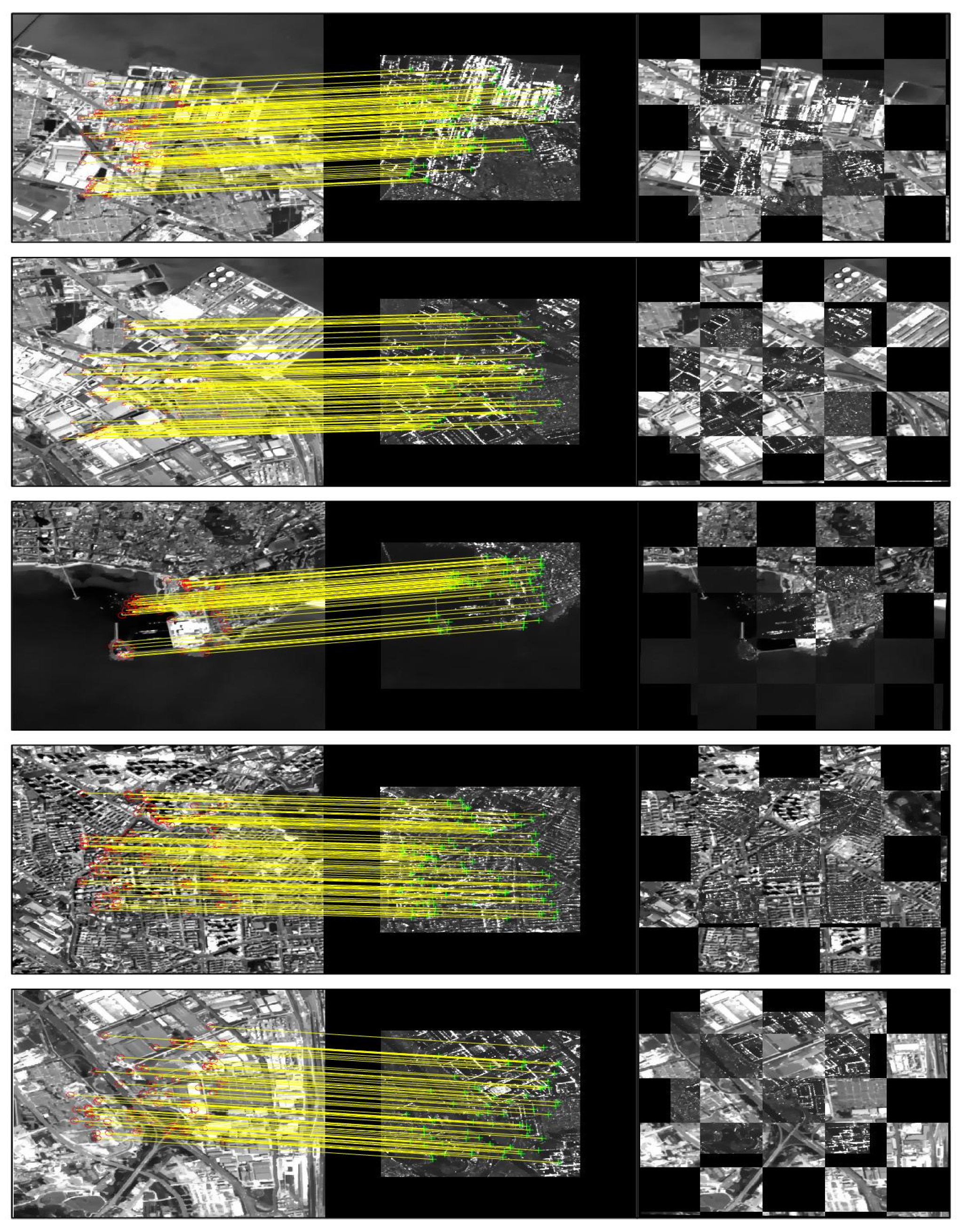
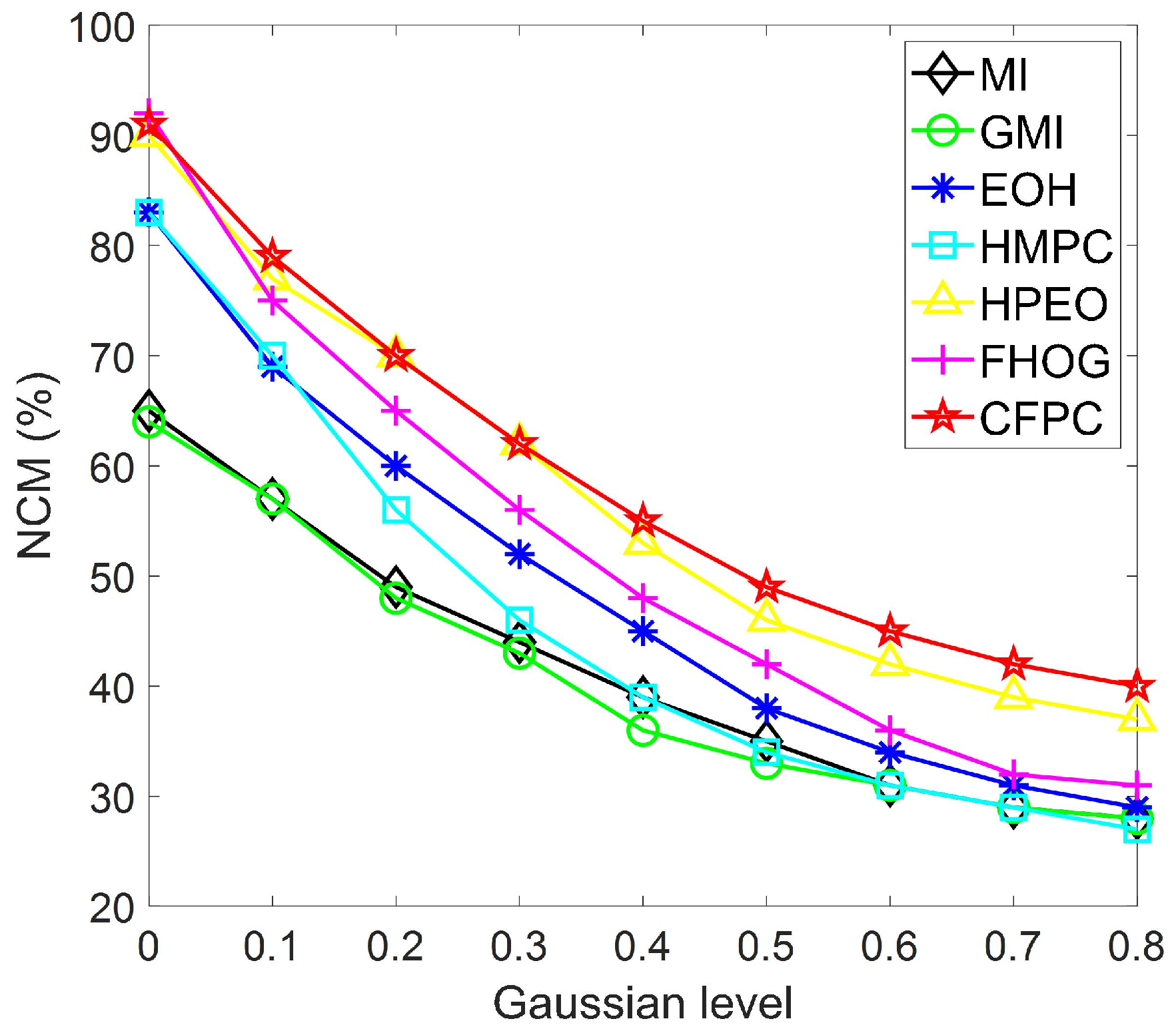
| Category | Test | Image Pair | Size and GSD | Date | Characteristics |
|---|---|---|---|---|---|
| (a) Visible–SAR | 1 | Google Earth | 528 × 524, 3 m | 11/2007 | These SAR images were collected in urban areas, and these SAR images contain significant noise. |
| TerraSAR-X | 534 × 524, 3 m | 12/2007 | |||
| 2 | TM band3 | 600 × 600, 30 m | 05/2007 | There is significant noise in these SAR images. The images have a temporal difference of 12 months. | |
| TerraSAR-X | 600 × 600, 30 m | 03/2008 | |||
| 3 | Google Earth | 628 × 618, 3 m | 03/2009 | These SAR images were collected in urban areas and have a temporal difference of 12 months. | |
| TerraSAR-X | 628 × 618, 3 m | 01/2008 | |||
| (b) LiDAR–visible | 1 | LiDAR height | 524 × 524, 2.5 m | 06/2012 | These SAR images were collected in urban areas, and these SAR images contain significant noise. |
| Airborne visible | 524 × 524, 2.5 m | 06/2012 | |||
| 2 | LiDAR intensity | 600 × 600, 2 m | 10/2010 | Temporal difference of 12 months; urban area. | |
| WordView2 visible | 600 × 600, 2 m | 10/2011 | |||
| 3 | LiDAR intensity | 621 × 617, 2 m | 10/2010 | Temporal difference of 12 months; urban area. | |
| WordView2 visible | 621 × 621, 2 m | 10/2011 | |||
| (c) Visible–infrared | 1 | Daedalus visible | 512 × 512, 0.5 m | 04/2000 | These images were collected in urban areas with high buildings. |
| Daedalus infrared | 512 × 512, 0.5 m | 04/2000 | |||
| 2 | Landsat 5 TM band 1 | 1074 × 1080, 30 m | 09/2001 | These SAR images were collected in urban areas and have a temporal difference of 6 months. | |
| Landsat 5 TM band 4 | 1074 × 1080, 30 m | 03/2002 | |||
| (d) Visible–map | 1 | Google Earth | 700 × 700, 0.5 m | / | These images were collected in urban areas, and there are some text labels on these SAR images. |
| Google Earth | 700 × 700, 0.5 m | / | |||
| 2 | Google Earth | 621 × 614, 1.5 m | / | These images were collected in urban areas, and there are some text labels on these SAR images. | |
| Google Earth | 621 × 614, 1.5 m | / |
| Template Size (Pixel) and Running Time (s) | Precision (%) and Noise Level | |||||
|---|---|---|---|---|---|---|
| Template, Noise | 50 × 50 | 70 × 70 | 90 × 90 | 0.1 | 0.4 | 0.7 |
| FHOG | 4.24 | 5.14 | 5.93 | 86.52 | 76.96 | 61.35 |
| HOPC | 4.75 | 7.52 | 10.21 | 87.13 | 69.14 | 56.35 |
| HMPC | 0.43 | 0.79 | 1.21 | 88.19 | 79.09 | 64.28 |
| FHOG + F-SSAD | 2.73 | 3.19 | 4.21 | 87.50 | 78.38 | 65.34 |
| HOPC + F-SSAD | 2.61 | 3.61 | 5.77 | 88.12 | 70.22 | 63.54 |
| HMPC + F-SSAD | 0.41 | 0.71 | 1.01 | 88.81 | 79.61 | 66.21 |
| Our method | 0.34 | 0.56 | 0.88 | 89.12 | 79.89 | 70.14 |
Disclaimer/Publisher’s Note: The statements, opinions and data contained in all publications are solely those of the individual author(s) and contributor(s) and not of MDPI and/or the editor(s). MDPI and/or the editor(s) disclaim responsibility for any injury to people or property resulting from any ideas, methods, instructions or products referred to in the content. |
© 2024 by the authors. Licensee MDPI, Basel, Switzerland. This article is an open access article distributed under the terms and conditions of the Creative Commons Attribution (CC BY) license (https://creativecommons.org/licenses/by/4.0/).
Share and Cite
Wu, Q.; Yu, Q. A Fast Sequential Similarity Detection Algorithm for Multi-Source Image Matching. Remote Sens. 2024, 16, 3589. https://doi.org/10.3390/rs16193589
Wu Q, Yu Q. A Fast Sequential Similarity Detection Algorithm for Multi-Source Image Matching. Remote Sensing. 2024; 16(19):3589. https://doi.org/10.3390/rs16193589
Chicago/Turabian StyleWu, Quan, and Qida Yu. 2024. "A Fast Sequential Similarity Detection Algorithm for Multi-Source Image Matching" Remote Sensing 16, no. 19: 3589. https://doi.org/10.3390/rs16193589
APA StyleWu, Q., & Yu, Q. (2024). A Fast Sequential Similarity Detection Algorithm for Multi-Source Image Matching. Remote Sensing, 16(19), 3589. https://doi.org/10.3390/rs16193589






